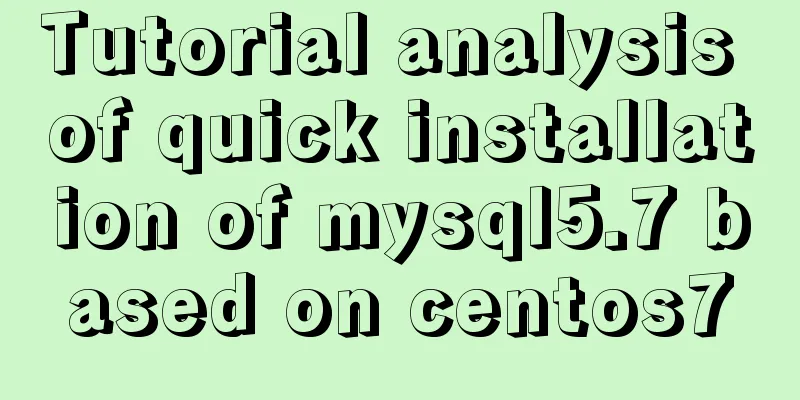Seven solutions for classic distributed transactions between MySQL and Golan

|
Preface: With the rapid development of business and the increasing complexity of business, almost every company's system will move from monolithic to distributed, especially to microservice architecture. Then, we will inevitably encounter the problem of distributed transactions. 1. Basic theoryBefore explaining the specific solution, let us first understand the basic theoretical knowledge involved in distributed transactions. Let's take money transfer as an example. If A needs to transfer 100 yuan to B, then the balance of A needs to be -100 yuan, and the balance of B needs to be +100 yuan. The entire transfer must ensure that A-100 and B+100 succeed at the same time, or fail at the same time. Let’s see how to solve this problem in various scenarios. 1.1 TransactionsThe function of operating multiple statements as a whole is called a database transaction. A database transaction can ensure that all operations within the scope of the transaction can succeed or fail. Transactions have four properties:
If our business system is not complicated and we can modify the data in one database and one service to complete the transfer, then we can use database transactions to ensure the correct completion of the transfer business. 1.2 Distributed Transactions Interbank transfer business is a typical distributed transaction scenario. Suppose A needs to transfer money to A distributed transaction means that the transaction initiator, resources and resource manager, and transaction coordinator are located on different nodes of the distributed system. In the above transfer business, user In a distributed environment, distributed transactions, in order to meet the needs of availability, performance and degraded services, reduce the requirements of consistency and isolation, on the one hand, follow the BASE theory (BASE-related theories involve a lot of content, interested students can refer to the BASE theory):
Similarly, distributed transactions also partially follow the ACID specification:
2. Distributed transaction solutions Due to the distributed transaction solution, it is impossible to achieve complete 2.1 Two-Phase Commit/XA XA is a distributed transaction specification proposed by XA is divided into two stages:
Currently, most mainstream databases support XA transactions, including An XA transaction consists of one or more resource managers (RMs), a transaction manager (TM), and an
Taking the above transfer as an example, the sequence diagram of a successfully completed XA transaction is as follows:
If any participant fails The characteristics of XA transactions are:
If readers want to further study 2.2 SAGA Saga is a solution mentioned in this database paper Taking the above transfer as an example, the sequence diagram of a successfully completed SAGA transaction is as follows:
Once Characteristics of Saga transactions:
If readers want to further study SAGA, they can refer to DTM, which includes examples of SAGA success and failure rollback, as well as the handling of various network exceptions. 2.3 TCC The concept of TCC is divided into 3 stages:
Taking the transfer above as an example, usually the amount will be frozen in Try but not deducted, deducted in The timing diagram of a successfully completed TCC transaction is as follows:
The features of TCC are as follows:
If readers want to further study 2.4 Local Message Table The local message table solution was originally proposed by The general process is as follows:
Writing local messages and business operations are placed in one transaction to ensure the atomicity of business and message sending. Either they all succeed or they all fail. Fault tolerance mechanism:
Features of the local message table:
Applicable to businesses that can be executed asynchronously and do not need to be rolled back for subsequent operations 2.5 Transaction Messages In the above-mentioned local message table solution, the producer needs to create an additional message table and also needs to poll the local message table, which places a heavy business burden. Alibaba's open source Transaction message sending and submission: Send message (half message) The normal sending flow chart is as follows:
Compensation process: For transaction messages without The characteristics of transaction messages are as follows:
Applicable to businesses that can be executed asynchronously and do not need to be rolled back for subsequent operations 2.6 Best Efforts NotificationThe initiator of notification uses a certain mechanism to make its best effort to notify the recipient of the business processing results. Specifically include: There is a certain message repeat notification mechanism. Because the recipient of the notification may not have received the notification, there must be a certain mechanism to repeat the message. Reliable message consistency: the party initiating the notification needs to ensure that the message is sent and sent to the receiving notification party. The reliability of the message is mainly guaranteed by the party initiating the notification. Best effort notification: the initiator of notification makes its best effort to notify the recipient of notification of the business processing result, but the message may not be received. In this case, the recipient of notification needs to actively call the initiator's interface to query the business processing result. The reliability of the notification depends on the recipient of notification. In terms of solutions, best efforts notification requires:
Best effort notification is applicable to business notification types. For example, the result of a WeChat transaction is notified to each merchant through best effort notification. There are callback notifications and transaction query interfaces. 2.7 AT Transaction ModeThis is a transaction mode in Alibaba's open source project Seata, also known as FMT in Ant Financial. The advantage is that the transaction mode is used in a similar way to the XA mode. The business does not need to write various compensation operations, and the rollback is automatically completed by the framework. The disadvantage is also similar to XA, with long locks, which does not meet high concurrency scenarios. From a performance perspective, AT mode is better than XA, but it also brings new problems such as dirty rollback. 3. Exception handlingNetwork and business failures may occur in every link of distributed transactions. These problems require the business party of distributed transactions to implement three features: anti-air rollback, idempotence, and anti-hanging. 3.1 Abnormal situationsThe following uses TCC transactions to illustrate these exceptions: Empty rollback: When the second-stage Cancel method is called without calling the TCC resource Try method, the Cancel method needs to recognize that this is an empty rollback and return success directly. The reason for this is that when a branch transaction is in a service downtime or network anomaly, the branch transaction call is recorded as failed. At this time, the Try phase is not executed. When the fault is recovered, the distributed transaction is rolled back and the Cancel method of the second phase is called, resulting in an empty rollback. Idempotence: Since any request may result in network anomalies and duplicate requests, all distributed transaction branches need to ensure idempotence. suspension: Suspension means that for a distributed transaction, the second-stage The reason for this is that when RPC calls the branch transaction try, the branch transaction is registered first, and then the RPC call is executed. If the network for the RPC call is congested at this time, after the RPC times out, TM will notify RM to roll back the distributed transaction. It is possible that after the rollback is completed, the RPC request of Try will reach the participant for actual execution. Let's take a look at a timing diagram of network anomalies to better understand the above problems.
In the face of the above complex network anomalies, the solutions currently recommended by various companies are that the business party uses a unique key to query whether the related operations have been completed, and if completed, directly return success. The relevant judgment logic is complex, prone to errors, and imposes a heavy business burden. 3.2 Subtransaction Barrier In the project https://github.com/yedf/dtm, a sub-transaction barrier technology has emerged. Using this technology, this effect can be achieved. See the schematic diagram:
All these requests, when they reach the subtransaction barrier, will be filtered out if they are abnormal, and will pass through the barrier if they are normal. After developers use subtransaction barriers, all the exceptions mentioned above are properly handled. Business developers only need to focus on the actual business logic, which greatly reduces their burden. The subtransaction barrier provides a method called ThroughBarrierCall, whose prototype is:
Business developers write their own related logic in busiCall and call this function. Subtransaction barriers manage TCC, SAGA, transaction messages, etc., and can also be extended to other areas 3.3 Subtransaction Barrier Principle The principle of subtransaction barrier technology is to establish a branch transaction status table
Under this mechanism, problems related to network anomalies are solved
For SAGA, transaction messages, etc., the mechanism is similar. 3.4 Summary of Subtransaction BarriersThe subtransaction barrier technology was first created by https://github.com/yedf/dtm. Its significance lies in designing a simple and easy-to-implement algorithm and providing a simple and easy-to-use interface. With the help of these two items, developers are completely freed from the handling of network exceptions. This technology currently needs to be used with the yedf/dtm transaction manager. The SDK is currently available to developers of Go and Python languages. SDKs for other languages are being planned. For other distributed transaction frameworks, as long as appropriate distributed transaction information is provided, the technology can be quickly implemented according to the above principles. 4. Distributed Transaction PracticeWe take the SAGA transaction introduced earlier as an example and use DTM as the transaction framework to complete a specific distributed transaction. This example uses the Go language. If you are not interested in this, you can jump directly to the summary at the end of the article. 4.1 A SAGA transactionLet's write the core business code first to adjust the user's account balance
func qsAdjustBalance(uid int, amount int) (interface{}, error) {
_, err := dtmcli.SdbExec(sdbGet(), "update dtm_busi.user_account set balance = balance + ? where user_id = ?", amount, uid)
return dtmcli.ResultSuccess, err
}
Next, let's write a specific forward operation/compensation operation processing function
app.POST(qsBusiAPI+"/TransIn", common.WrapHandler(func(c *gin.Context) (interface{}, error) {
return qsAdjustBalance(2, 30)
}))
app.POST(qsBusiAPI+"/TransInCompensate", common.WrapHandler(func(c *gin.Context) (interface{}, error) {
return qsAdjustBalance(2, -30)
}))
app.POST(qsBusiAPI+"/TransOut", common.WrapHandler(func(c *gin.Context) (interface{}, error) {
return qsAdjustBalance(1, -30)
}))
app.POST(qsBusiAPI+"/TransOutCompensate", common.WrapHandler(func(c *gin.Context) (interface{}, error) {
return qsAdjustBalance(1, 30)
}))
At this point, the processing functions of each sub-transaction have been OK, and then the SAGA transaction is opened to make branch calls
req := &gin.H{"amount": 30} // Microservice payload // DtmServer is the address of the DTM service saga := dtmcli.NewSaga(DtmServer, dtmcli.MustGenGid(DtmServer)).
// Add a TransOut subtransaction. The forward operation is url: qsBusi+"/TransOut", and the reverse operation is url: qsBusi+"/TransOutCompensate"
Add(qsBusi+"/TransOut", qsBusi+"/TransOutCompensate", req).
// Add a TransIn subtransaction. The forward operation is url: qsBusi+"/TransOut", and the reverse operation is url: qsBusi+"/TransInCompensate"
Add(qsBusi+"/TransIn", qsBusi+"/TransInCompensate", req)
// Submit the saga transaction, dtm will complete all subtransactions/rollback all subtransactions err := saga.Submit()
At this point, a complete SAGA distributed transaction has been written. If you want to run a successful example in its entirety, set up the environment according to the instructions of the yedf/dtm project and run the saga example with the following command:
4.2 Handling Network AnomaliesWhat should I do if a brief failure occurs when calling the transfer operation in a transaction submitted to dtm? According to the SAGA transaction protocol, dtm will retry unfinished operations. What should we do at this time? The fault may be a network failure after the transfer operation is completed, or the machine may crash during the transfer operation. How can we ensure that the adjustment of account balance is correct? We use the subtransaction barrier function to ensure that after multiple retries, only one successful submission will occur. We adjust the processing function to:
func sagaBarrierAdjustBalance(sdb *sql.Tx, uid int, amount int) (interface{}, error) {
_, err := dtmcli.StxExec(sdb, "update dtm_busi.user_account set balance = balance + ? where user_id = ?", amount, uid)
return dtmcli.ResultSuccess, err
}
func sagaBarrierTransIn(c *gin.Context) (interface{}, error) {
return dtmcli.ThroughBarrierCall(sdbGet(), MustGetTrans(c), func(sdb *sql.Tx) (interface{}, error) {
return sagaBarrierAdjustBalance(sdb, 1, reqFrom(c).Amount)
})
}
func sagaBarrierTransInCompensate(c *gin.Context) (interface{}, error) {
return dtmcli.ThroughBarrierCall(sdbGet(), MustGetTrans(c), func(sdb *sql.Tx) (interface{}, error) {
return sagaBarrierAdjustBalance(sdb, 1, -reqFrom(c).Amount)
})
}
The You can try calling this TransIn service multiple times and the balance will be adjusted only once. You can run the new process by running the following command: 4.3 Handling RollbackWhat will happen if the bank discovers an abnormality in User 2's account when preparing to transfer the amount to User 2 and returns a failure? We adjust the processing function to make the transfer operation return failure
func sagaBarrierTransIn(c *gin.Context) (interface{}, error) {
return dtmcli.ResultFailure, nil
}
We give a timing diagram of transaction failure interaction
There is one thing here. The forward operation of Don't worry. The previous subtransaction barrier technology can ensure that if You can change the TransIn that returns an error to:
func sagaBarrierTransIn(c *gin.Context) (interface{}, error) {
dtmcli.ThroughBarrierCall(sdbGet(), MustGetTrans(c), func(sdb *sql.Tx) (interface{}, error) {
return sagaBarrierAdjustBalance(sdb, 1, 30)
})
return dtmcli.ResultFailure, nil
}
The final result is that the balance is still fine 5. SummaryThis article introduces some basic theories of distributed transactions and explains commonly used distributed transaction solutions. The second half of the article also gives the causes, classifications, and elegant solutions for transaction exceptions. Finally, a runnable distributed transaction example is used to demonstrate the previously introduced content in a short program. This is the end of this article about the seven classic solutions for MySQL and Golan distributed transactions. For more information about the seven classic solutions for distributed transactions, please search for previous articles on 123WORDPRESS.COM or continue to browse the following related articles. I hope you will support 123WORDPRESS.COM in the future! You may also be interested in:
|
<<: Vue implements custom "modal pop-up window" component example code
Recommend
CentOS8 network card configuration file
1. Introduction CentOS8 system update, the new ve...
Using js to achieve the effect of carousel
Today, let's talk about how to use js to achi...
Tutorial on using $attrs and $listeners in Vue
Table of contents introduce Example Summarize int...
Solution to HTML encoding problem in IE6 that causes JS error and CSS not being applied
It was found in the test that when the page defini...
What does input type mean and how to limit input
Common methods for limiting input 1. To cancel the...
JavaScript to implement drop-down list selection box
This article example shares the specific code of ...
Example of implementing a 16:9 rectangle with adaptive width and height using CSS
Earlier we talked about how to make a square with...
Detailed explanation of Vue + Axios request interface method and parameter passing method
Table of contents 1. Get request: 2. Post request...
Detailed steps to deploy lnmp under Docker
Table of contents Pull a centos image Generate ng...
Programs to query port usage and clear port usage in Windows operating system
In Windows operating system, the program to query...
Correct use of Vue function anti-shake and throttling
Preface 1. Debounce: After a high-frequency event...
Detailed explanation of the MySQL MVCC mechanism principle
Table of contents What is MVCC Mysql lock and tra...
In-depth study of JavaScript array deduplication problem
Table of contents Preface 👀 Start researching 🐱🏍...
MySQL 5.7.17 installation and configuration tutorial for Mac
1. Download MySQL Click on the official website d...
Detailed explanation of the process of deploying MySql on Centos server and connecting to Navicat
(1) Server configuration: [root@localhost ~]# cd ...

















